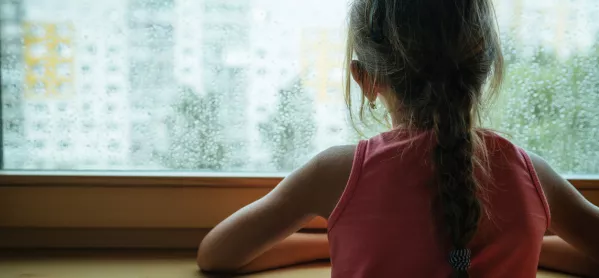Covid: Where is pupil and teacher absence heading?

Covid disruption is continuing to hit schools, with increasing numbers of pupils and staff catching the virus as the term goes on.
But the increase in cases in schools has slowed compared with the sharp rise seen last month.
The Department for Education has published its latest attendance figures showing absence levels in England’s state schools last week.
Warning: Heads raise staffing fears as Covid rates among teachers doubles
Inspection: Education secretary wants Ofsted to help improve attendance
Cases rising: More than 200,000 pupils off because of Covid
Zahawi: ‘We won’t let school attendance fall’
Here are six key findings:
1. The increase in pupil Covid rates has slowed
After Covid-related absence soared during September, today’s data shows a much smaller increase.
There were 111,000 pupils off with a confirmed case of the virus on Thursday last week - up from 102,000 two weeks earlier.
Meanwhile, the number of students with a suspected case dropped slightly, from 84,000 to 81,000.
In total, 2.6 per cent of pupils were off last week for Covid-related reasons, compared with 2.5 per cent a fortnight ago.
This is in stark contrast to last month, when Covid rates rose sharply. The first set of data from this term, published on 16 September, showed 59,000 pupils had been off school due to catching the virus the previous week - rising to 102,000 by the end of the month.
2. Covid rates are much higher now than when absence peaked last term
Covid-related absence is a fraction of what it was before the summer holidays, when more pupils were expected to self-isolate.
Figures collected from schools in July showed a Covid-related absence rate of 14.3 per cent, compared with the most recent figure of 2.6 per cent.
But the vast majority of July’s absentees were children who had been asked to self-isolate as close contacts, rather than because they had tested positive for the virus.
The number of pupils testing positive for Covid is now higher than it has been at any point during the pandemic - and more than double what it was when schools broke up for the summer.
However, the biggest surge in numbers was seen two weeks ago.
//--> //--> //--> //--> //--> //--> //--> //--> //--> //--> //--> //--> //--> //--> //--> //--> //--> //--> //--> //--> //--> //--> //--> //--> //--> //--> //--> //--> //--> //--> //--> //--> //--> //--> //--> //--> //--> //--> //--> //--> //--> //--> //-->
The peak of Covid cases among pupils last term was 47,000 on 15 July, compared with 111,000 in the latest figures.
3. Most Covid absence is now directly related to the virus
With schools no longer operating in bubbles and pupils no longer being expected to self-isolate because they are a close contact, most of the Covid absence now is either pupils who have the virus or a suspected case of it.
Of the 2.6 per cent of pupils absent for Covid-related reasons last Thursday, the majority either had Covid (1.4 per cent) or a suspected case (1 per cent).
The remaining pupils who were off due to Covid included 5,000 pupils absent from open settings because of attendance restrictions being in place to manage an outbreak, and 11,000 pupils absent from open settings “due to isolation for other reasons”.
4. Covid among teachers has more than doubled
While much of the focus has been on the number of pupils with Covid, this term has also seen a marked increase in the proportion of school staff testing positive for the virus, particularly among school leaders and teachers.
Figures published today show that the Covid rate among teachers and headteachers is now more than double what it was in the middle of September.
5. Heads are worried about Covid staffing disruption
School leaders’ unions have warned the government that the slowing down of Covid growth in schools should not detract from the scale of the disruption they are facing.
Geoff Barton, the general secretary of the Association of School and College Leaders, said the problems had been exacerbated by an “acute shortage of suitably qualified supply staff”.
Meanwhile, James Bowen, director of policy for school leaders’ union the NAHT, called for the government to do more to control the spread of the virus.
6. ‘Non-Covid-related’ absence has dropped but remains high
Although Covid-related absence has increased compared with two weeks ago, according to DfE data, the overall level of absence has dropped.
However, there are still around one in 10 pupils not in school.
Two weeks ago, overall attendance was 89.5 per cent - which included 2.5 per cent of pupils not in school for Covid-related reasons.
The latest figures show that overall attendance increased to 90 per cent on Thursday 14 October - despite a slight increase of 0.1 per cent in Covid-related absence.
Education secretary Nadhim Zahawi has asked the Department for Education to carry out a “deep dive” into attendance and has suggested Ofsted inspections could be used to improve it.
Has attendance fallen for reasons other than Covid or do the figures point to absences being indirectly caused by the pandemic?
It is hard to say for sure, but 7.4 per cent of pupils were absent last week for reasons that were not designated as being related to Covid - whereas the absence rate for 2018-19, the last full academic year not affected by the coronavirus pandemic, was just 4.7 per cent.
You need a Tes subscription to read this article
Subscribe now to read this article and get other subscriber-only content:
- Unlimited access to all Tes magazine content
- Exclusive subscriber-only stories
- Award-winning email newsletters
Already a subscriber? Log in
You need a subscription to read this article
Subscribe now to read this article and get other subscriber-only content, including:
- Unlimited access to all Tes magazine content
- Exclusive subscriber-only stories
- Award-winning email newsletters



